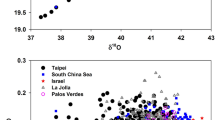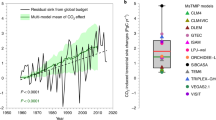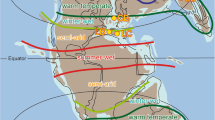Abstract
This report provides information on a potentially important new atmospheric tracer of large-scale behaviour at the Earth's surface, the oxygen isotope composition of CO2. We use measurements on flask air collected from Alaska, Hawaii, Samoa, Tasmania, coastal Antarctica and the South Pole. Recently, we examined 1982–84 measurements of δ18O in CO2 extracted in situ from marine air at Cape Grim, Tasmania1. Here we report on a comparison of Cape Grim flask and in situ data that gives a measure of precision and serves to demonstrate a marked improvement over previous infrequent measurements. While previous data2,3 suggests a north-south gradient, our flask data establish a strong, asymmetric meridional gradient. We argue that this reflects the oxygen isotope ratio in ground water, via mechanisms involving gross catalysed CO2 exchange with leaf (and possibly soil) water. Very large CO2 fluxes are involved, of the order of 200 Gt carbon (C) yr−1.
This is a preview of subscription content, access via your institution
Access options
Subscribe to this journal
Receive 51 print issues and online access
$199.00 per year
only $3.90 per issue
Buy this article
- Purchase on Springer Link
- Instant access to full article PDF
Prices may be subject to local taxes which are calculated during checkout
Similar content being viewed by others
References
1. Tans, P. P., Francey, R. J. & Pearman, G. I. in Baseline 83–84 (eds Francey, R. J. & Forgan, B. W.) 10–14 (Bureau of Meteorology/CSIRO Division of Atmospheric Research, Australia, 1986). 2. Keeling, C. D., Carter, A. F. & Mook, W. G. / geophys. Res. 89, 4615–4628 (1984). 3. Mook, W. G., Koopmans, M., Carter, A. F. & Keeling, C. D. /. geophys. Res. 88,10915–10933 (1983). 4. Francey, R. J. & Goodman, H. S. in Baseline 83–84 (eds Francey, R. J. & Forgan, B. W.) 27–36 (Bureau of Meteorology/CSIRO Division of Atmospheric Research, Australia, 1986). 5. Joussaume, S., Sadourny, R. & Jouzel, J. Nature 311, 24–29 (1984). 6. Pearman, G. I. & Hyson, P. J. atmos. Chem. 4, 81–124 (1986). 7. Pearman, G., Hyson, P. & Fraser, P. J. J. geophys. Res. 88, 3581–3590 (1983). 8. Bottinga, Y. & Craig, H. Earth planet. Sci. Lett. 5, 285–295 (1969). 9. Mills, G. A. & Urey, H. C. /. Am. chem. Soc. 62, 1019–1026 (1940). 10. Feigel'son, E. M. Radiant Heat Transfer in a Cloudy Atmosphere (translated by Lederman, D.) (Israel Program for Scientific Translations, Jerusalem, 1973). 11. Kroopnick, P. & Craig, H. Science 175, 54–55 (1972). 12. Dole, M., Lane, G. A., Rudd, D. P. & Zaukelies, D. A. Geochim. cosmochim. Acta 6, 65–78 (1954). 13. Reed, M. & Graham, D. in Progress in Phytochemistry Vol. 7 (eds Reinhold, L., Marbone, J. & Swain, T.) 47–94 (Interscience Publishers, London, 1981). 14. Silverman, D. N. Methods in Enzymology 87, 732–752 (1982). 15. Larcher, W. Physiological Plant Ecology (Springer, Berlin, 1975). 16. Epstein, S., Thompson, P. & Yapp, C. J. Science 198, 1209–1215 (1977). 17. Newsome, D. S. Catal. Rev. Sci. Engng 21, 275–318 (1980).
Author information
Authors and Affiliations
Rights and permissions
About this article
Cite this article
Francey, R., Tans, P. Latitudinal variation in oxygen-18 of atmospheric CO2. Nature 327, 495–497 (1987). https://doi.org/10.1038/327495a0
Received:
Accepted:
Issue Date:
DOI: https://doi.org/10.1038/327495a0
This article is cited by
-
New constraints of terrestrial and oceanic global gross primary productions from the triple oxygen isotopic composition of atmospheric CO2 and O2
Scientific Reports (2023)
-
Adsorption separation of heavier isotope gases in subnanometer carbon pores
Nature Communications (2021)
-
Leaf scale quantification of the effect of photosynthetic gas exchange on Δ47 of CO2
Scientific Reports (2021)
-
Soil exchange rates of COS and CO18O differ with the diversity of microbial communities and their carbonic anhydrase enzymes
The ISME Journal (2019)
-
Oxygen isotope anomaly in tropospheric CO2 and implications for CO2 residence time in the atmosphere and gross primary productivity
Scientific Reports (2017)
Comments
By submitting a comment you agree to abide by our Terms and Community Guidelines. If you find something abusive or that does not comply with our terms or guidelines please flag it as inappropriate.



